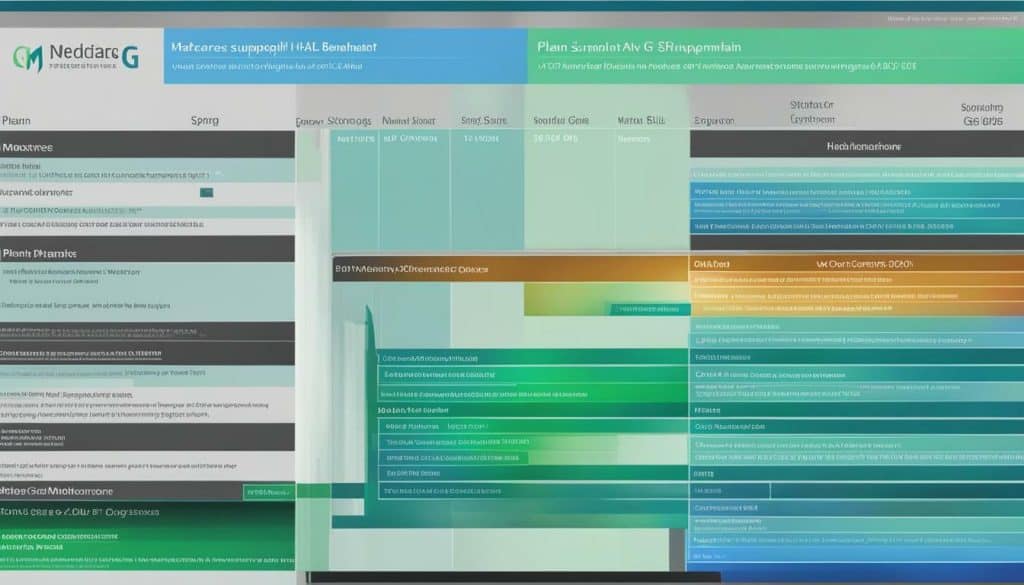If you’re considering Medicare Supplement plans, understanding the differences between Plan N and Plan G is crucial. These two options, Medicare Supplement Plan N and Plan G, are popular choices for individuals looking to fill the gaps in their Medicare coverage. With the discontinued availability of Plan F, Plan N has emerged as a comparable alternative, offering similar benefits with the exception of not covering the Part B deductible. On the other hand, Plan G is widely regarded as the most comprehensive Medicare Supplement plan, covering all costs except for the Part B deductible. It’s important to note that both Plan N and Plan G may vary in cost based on factors such as location, age, and health status. Taking the time to carefully consider your healthcare needs and comparing the plans available to you is crucial in making an informed decision.
Key Takeaways:
- Medicare Supplement Plan N and Plan G are popular options for filling gaps in Medicare coverage.
- Plan N offers similar benefits to the now-discontinued Plan F but does not cover the Part B deductible.
- Plan G is considered the most comprehensive Medicare Supplement plan, covering all costs except for the Part B deductible.
- Costs for both Plan N and Plan G can vary based on factors such as location, age, and health status.
- Choosing the right plan requires careful consideration of your healthcare needs.
Medicare Supplement Plan N Benefits
Medicare Supplement Plan N offers a comprehensive range of benefits, ensuring you have coverage for various medical expenses. This plan is designed to fill the gaps in Original Medicare, giving you peace of mind and financial protection.
With Medicare Supplement Plan N, you will have coverage for hospital stays, skilled nursing facility care, and hospice care coinsurance or copayments. In addition, this plan covers your Part A deductible, which is the amount you must pay before Medicare starts covering your hospital expenses.
Plan N also offers coverage for Part B coinsurance and copayments, ensuring that you don’t have to worry about out-of-pocket costs when visiting healthcare providers. However, it’s important to note that Plan N does not cover the Part B deductible, which is an annual amount you must pay before Medicare begins paying its share for outpatient services.
Furthermore, Medicare Supplement Plan N gives you the freedom to choose any doctor or hospital that accepts Medicare patients, with no network restrictions. This means that you can seek medical care from the provider of your choice, without worrying about whether they are in-network or out-of-network.
Table: Medicare Supplement Plan N Benefits
| Benefits | Coverage |
|---|---|
| Hospital Stays (Part A) | Full coverage after deductible |
| Skilled Nursing Facility Care | Full coverage after deductible |
| Hospice Care Coinsurance or Copayments | Full coverage after deductible |
| Part A Deductible | Full coverage |
| Part B Coinsurance and Copayments | Full coverage, except for Part B deductible |
Medicare Supplement Plan N is an excellent choice for individuals who want substantial coverage without the high premiums associated with Plan F. It provides a solid level of protection, ensuring that you can access the healthcare services you need without breaking the bank.

“Medicare Supplement Plan N offers comprehensive coverage and flexibility to choose your own healthcare providers. It fills the gaps in Original Medicare, ensuring that you have financial protection and peace of mind.”
Medicare Supplement Plan G Benefits
Medicare Supplement Plan G is known for its extensive coverage, providing comprehensive protection against healthcare costs. With Plan G, you have the peace of mind knowing that most of your medical expenses will be covered, leaving you with minimal out-of-pocket expenses.
One of the key benefits of Plan G is that it covers the Part A deductible, which is the cost associated with hospital stays. This means that if you need to be hospitalized, Plan G will cover the deductible, giving you financial relief.
In addition to hospital stays, Plan G also covers the coinsurance and copayment for skilled nursing facilities, as well as the Part B excess charges. This means that if your healthcare provider charges more than the Medicare-approved amount for a service, Plan G will cover the difference.
| Coverage | Medicare Supplement Plan G |
|---|---|
| Hospital Stays | Covered, including Part A deductible |
| Skilled Nursing Facilities | Covered, including coinsurance and copayment |
| Part B Excess Charges | Covered |
Plan G offers comprehensive coverage, ensuring that you are protected from unexpected healthcare costs. It provides the peace of mind knowing that you won’t have to worry about significant out-of-pocket expenses.
It’s important to note that Plan G does not cover the Part B deductible, which is an annual cost that Medicare beneficiaries need to pay before their coverage kicks in. However, considering the coverage it offers, many individuals find that the benefits of Plan G outweigh the Part B deductible.
When comparing plans, it’s crucial to assess your healthcare needs and budget. While Plan G may have a slightly higher premium compared to other Medicare Supplement plans, the comprehensive coverage it provides can ultimately save you money in the long run.
Now that we’ve explored the benefits of Medicare Supplement Plan G, let’s take a closer look at the key differences between Plan N and Plan G in the next section.
Next: Key Differences Between Medicare Supplement Plan N and Plan G
Key Differences Between Medicare Supplement Plan N and Plan G
While both Plan N and Plan G offer valuable coverage, there are some notable differences that can impact your healthcare expenses. One key difference is that Plan N does not cover the Medicare Part B deductible, while Plan G does. The Part B deductible is an annual cost that beneficiaries must pay out of pocket before their Medicare coverage kicks in for certain services.
Another difference between the two plans is how they handle excess charges. Excess charges are additional fees that healthcare providers can charge above the Medicare-approved amount. With Plan N, you may be responsible for paying any excess charges out of pocket. However, Plan G covers these excess charges, giving you peace of mind that you won’t face unexpected costs when seeking medical care.
Cost-sharing is also a factor to consider when comparing Plan N and Plan G. Plan N has lower monthly premiums compared to Plan G, but it does require co-payments for certain services, such as doctor visits and emergency room visits. On the other hand, Plan G has higher premiums but offers more comprehensive coverage with minimal out-of-pocket expenses.
| Plan N | Plan G |
|---|---|
| Does not cover Medicare Part B deductible | Covers Medicare Part B deductible |
| May have out-of-pocket costs for excess charges | Covers excess charges |
| Lower monthly premiums | Higher monthly premiums |
| Requires co-payments for certain services | Minimal out-of-pocket expenses |
Choosing between Plan N and Plan G ultimately depends on your individual healthcare needs and financial situation. If you prefer lower monthly premiums and are willing to pay some out-of-pocket costs, Plan N may be a suitable option for you. However, if you want more comprehensive coverage with minimal out-of-pocket expenses, Plan G might be the better choice.
It’s important to note that the availability and cost of Plan N and Plan G can vary depending on your location, age, and health status. Before making a decision, it’s recommended to compare the specific benefits and costs of each plan in your area. Consider consulting with a licensed insurance agent or using online resources to ensure you have all the information you need to make an informed decision about your Medicare supplement plan.

Medicare Supplement Plan N provides coverage for a wide range of medical services, protecting you from unexpected healthcare expenses. This plan includes coverage for Medicare Part A coinsurance and hospital costs, as well as coverage for Part B coinsurance or copayment. Additionally, Plan N covers the first three pints of blood needed for a medical procedure and provides coverage for skilled nursing facility care coinsurance. It also covers Medicare Part A hospice coinsurance or copayment, ensuring peace of mind during difficult times.
Furthermore, Medicare Supplement Plan N covers 100% of the Medicare Part B coinsurance or copayment, except for a copayment of up to $20 for some office visits and up to $50 for emergency room visits that don’t result in inpatient admission. This cost-sharing feature of Plan N allows for slightly lower premiums compared to other Medicare Supplement plans.
It is important to note that Medicare Supplement Plan N does not cover the Part B deductible, which you must pay out of pocket. However, once the deductible is met, Plan N covers the remaining Part B expenses at 100%. This plan offers a balance between comprehensive coverage and affordability, making it a popular choice for many individuals.

When considering Medicare Supplement Plan N, it’s essential to evaluate your specific healthcare needs and preferences. While Plan N offers robust coverage, it’s important to note that it does not cover excess charges. Excess charges are the additional amount that some doctors or healthcare providers charge above the Medicare-approved amount.
It is crucial to weigh the potential cost savings of Plan N against potential excess charges that may arise. If you frequently seek medical services from providers who may charge excess fees, you may want to consider Medicare Supplement Plan G, which covers excess charges. Plan G provides comprehensive coverage, including the Part B deductible, and is a suitable option for individuals who value the peace of mind that comes with knowing all their healthcare costs are covered.
Summary
Medicare Supplement Plan N offers extensive coverage for a variety of medical services, protecting you from unexpected expenses. While it does not cover the Part B deductible, it provides coverage for most other Medicare costs, making it an attractive option for many individuals. However, it’s important to carefully consider your specific healthcare needs and preferences before making a decision. Comparing different Medicare Supplement plans, such as Plan N and Plan G, can help you find the most suitable option for your situation.
| Medicare Supplement Plan N Coverage | Medicare Supplement Plan G Coverage |
|---|---|
| Coverage for Medicare Part A coinsurance and hospital costs | Coverage for Medicare Part A coinsurance and hospital costs |
| Coverage for Medicare Part B coinsurance or copayment | Coverage for Medicare Part B coinsurance or copayment |
| Coverage for the first three pints of blood needed for a medical procedure | Coverage for the first three pints of blood needed for a medical procedure |
| Coverage for skilled nursing facility care coinsurance | Coverage for skilled nursing facility care coinsurance |
| Coverage for Medicare Part A hospice coinsurance or copayment | Coverage for Medicare Part A hospice coinsurance or copayment |
| 100% coverage of Medicare Part B coinsurance or copayment, except for copayment of up to $20 for office visits and up to $50 for emergency room visits | 100% coverage of Medicare Part B coinsurance or copayment |
| Does not cover the Part B deductible | Covers the Part B deductible |
| Does not cover excess charges | Covers excess charges |
Medicare Supplement Plan G Coverage
With Medicare Supplement Plan G, you can enjoy comprehensive coverage for a variety of healthcare services, ensuring peace of mind in managing medical bills. Plan G covers the gaps left by Original Medicare, providing an extensive range of benefits that can significantly reduce out-of-pocket expenses.
One of the key advantages of Medicare Supplement Plan G is that it covers the Part A hospital deductible, which can save you thousands of dollars in the event of a hospitalization. In addition to this, Plan G covers 100% of Medicare Part B coinsurance or copayment amounts, meaning you won’t have to worry about paying a portion of your medical services.
Medicare Supplement Plan G also offers coverage for skilled nursing facility care, Medicare Part A hospice care coinsurance or copayment, and the first three pints of blood per year. It even extends coverage for foreign travel emergencies. Plan G is designed to provide comprehensive coverage, giving you the confidence and financial protection you need when it comes to your healthcare.
Medicare Supplement Plan G Coverage Table
| Benefits | Coverage |
|---|---|
| Medicare Part A hospital deductible | Covered |
| Medicare Part A hospital coinsurance and costs up to an additional 365 days after Medicare benefits are exhausted | Covered |
| Medicare Part A hospice care coinsurance or copayment | Covered |
| Medicare Part B coinsurance or copayment | Covered at 100% |
| First three pints of blood per year | Covered |
| Skilled nursing facility care coinsurance | Covered |
| Foreign travel emergency coverage | 80% covered, up to plan limits |

With its comprehensive coverage and a wide range of benefits, Medicare Supplement Plan G is a popular choice among individuals who want to enhance their Medicare benefits and minimize out-of-pocket expenses. Keep in mind that the availability and cost of Medicare Supplement plans can vary depending on your location, age, and health status. It’s crucial to compare the different plans available to you and consider your individual healthcare needs before making a decision.
Medicare Supplement Plan N vs Plan G Costs and Reviews
Understanding the costs and reviews of Medicare Supplement Plan N and Plan G is essential to make an informed decision about your healthcare coverage. While both plans offer valuable benefits, it’s important to compare the costs associated with each plan and consider the experiences of others who have chosen these options.
When it comes to costs, Medicare Supplement Plan N generally has lower monthly premiums compared to Plan G. However, it’s important to note that Plan N does require cost-sharing, including a copayment for doctor visits and a deductible for emergency room visits. On the other hand, Plan G offers more comprehensive coverage, including coverage for the Part B deductible. This means that with Plan G, you will have fewer out-of-pocket expenses.
Reviews from individuals who have chosen these plans can provide valuable insights. Some individuals prefer the lower premiums of Medicare Supplement Plan N and are willing to accept cost-sharing for certain services. Others appreciate the comprehensive coverage of Plan G and the peace of mind that comes with knowing that most of their healthcare costs are covered.
Ultimately, the choice between Medicare Supplement Plan N and Plan G depends on your individual healthcare needs and financial situation. It’s important to carefully consider the costs and coverage offered by each plan and weigh them against your personal preferences and budget. Consulting with a licensed insurance agent can also help you navigate the complexities of these plans and make the best decision for your specific circumstances.

Choosing between Medicare Supplement Plan N and Plan G depends on your specific health needs and financial considerations.
Medicare Supplement Plan N offers comprehensive coverage, similar to the now unavailable Plan F, but does not cover the Part B deductible. With Plan N, you can expect assistance with hospitalization costs, skilled nursing facility care, and even foreign travel emergency expenses. However, you will be responsible for the Part B deductible, as well as some copayments and excess charges. If you are willing to take on these out-of-pocket costs in exchange for slightly lower monthly premiums, Plan N may be the right choice for you.
On the other hand, Medicare Supplement Plan G is renowned for its comprehensive coverage. It covers all expenses included in Plan N, except for the Part B deductible. This means that with Plan G, you can enjoy greater peace of mind knowing that you will have minimal out-of-pocket costs for hospital and medical services. If you are someone who prefers more predictable costs and is willing to pay a slightly higher premium in exchange for comprehensive coverage, Plan G may be the better option.
Ultimately, the decision between Plan N and Plan G should be based on your individual needs and circumstances. Consider factors such as your health status, budget, and the level of financial risk you are willing to assume. It may be helpful to consult with a Medicare specialist or insurance agent who can provide personalized advice and help you navigate the complex world of Medicare Supplement plans.
FAQ
Q: What is the main difference between Medicare Supplement Plan N and Plan G?
A: The main difference between Medicare Supplement Plan N and Plan G is that Plan N does not cover the Part B deductible, while Plan G covers all costs except the Part B deductible.
Q: Can you explain the coverage provided by Medicare Supplement Plan N?
A: Medicare Supplement Plan N offers similar benefits to Plan F, but does not cover the Part B deductible. It covers hospital costs, Part A coinsurance, and Part A hospice care coinsurance, among other expenses.
Q: What are the benefits of Medicare Supplement Plan G?
A: Medicare Supplement Plan G is considered the most comprehensive of the Medicare Supplement plans. It covers all costs except the Part B deductible, including hospital costs, Part A coinsurance, and skilled nursing facility coinsurance.
Q: How do Medicare Supplement Plan N and Plan G differ in terms of costs?
A: The costs of Medicare Supplement Plan N and Plan G can vary depending on factors such as location, age, and health status. However, Plan G is generally expected to have higher premiums compared to Plan N due to its more extensive coverage.
Q: What should I consider when choosing between Medicare Supplement Plan N and Plan G?
A: When choosing between Medicare Supplement Plan N and Plan G, it is important to carefully consider your healthcare needs and budget. Evaluate the coverage offered by each plan, the associated costs, and any out-of-pocket expenses that may arise.










